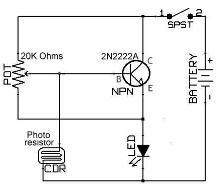
2 minute read
Train Position Using a CdS cell with LED output
Page 6
DC DCC
Advertisement
The Photo resistor, sometimes called a Light Dependent Resistor (LDR or CdS cell), should have a light on resistance of about 1,000 to 5,000 ohms. They are sensitive to visible light and can be packaged in metal cans or encased in moisture resistant epoxy.

Operation:-
The light shining on the photo resistor makes its resistance low which makes a low voltage on the transistor base (b). This is passed to the emitter (e) but will not be sufficient to light the LED. When the photo resistor is covered its resistance increases to a high value, gives a higher voltage on the emitter and current flows from the collector ᄅ to the LED. To operate reliably a 3 volt battery is needed. A multi-output Plug pack, 3 to 12 volts unregulated DC could be used in place of the battery. The circuit will work up to 12 volts from a DC power supply but care is needed in the adjustment as the LED could be burnt out at the higher voltage.


Adjustment:- Set the 20K potentiometer at about half way and with the photo resistor covered (Dark) by whatever you are sensing, adjust the potentiometer so the LED is on at the brightness you want. Uncover the photo resistor and the LED should go off. If not readjust so the LED is less bright. Current drain:- If you are using a battery, the current drain of this circuit will be about 0.25 milliamps per detector, which should give it several months operation on 'D' cells. However you will probably have several detectors running through a tunnel or along a hidden yard and supplied by the one battery so Installation:- a power on/off switch would be advisable. The photo resistor needs a moderately strong ambient light to reduce its resistance to a low enough value. If there is not enough light where you want to place the detector then a small bulb will need to be installed to shine on the cell. You could mount Construction:- The components can be mounted on a piece of strip board (vero board) and can be fitted into a 4 hole by 10 hole area - see diagram. this low down to the side of the rails and shine it up across the space that the train will pass through and on to the photo resistor mounted above and on the other side of the rails. A shield or tube could be put over the light to stop it being visible from the side. Many other means of getting light to the detector could be devised. The picture shows the CdS cell mounted on the vero/strip board but it can be on flying leads somewhere on the layout and the LED and PCB mounted on a convenient track side panel. Multiple PCB's and LED's could be mounted side by side as they are very small.










